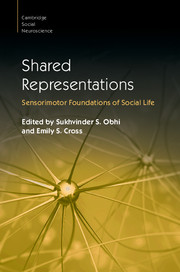Book contents
- Shared Representations
- Cambridge Social Neuroscience
- Shared Representations
- Copyright page
- Contents
- Figures
- Tables
- Boxes
- Contributors
- Preface
- Part I Foundations
- Part II Imitation and Mimicry
- Part III Thinking, Perceiving and Acting with Others
- Part IV Understanding Others
- Part V Learning and Development
- Part VI Shared Representations in Applied Contexts
- 27 Sport Performance
- 28 Shared Mental Models in Sport and Refereeing
- 29 Musical Synchronization, Social Interaction and the Brain
- 30 You Move, I Watch, It Matters
- Index
- Plate Section (PDF Only)
- References
28 - Shared Mental Models in Sport and Refereeing
from Part VI - Shared Representations in Applied Contexts
Published online by Cambridge University Press: 27 October 2016
- Shared Representations
- Cambridge Social Neuroscience
- Shared Representations
- Copyright page
- Contents
- Figures
- Tables
- Boxes
- Contributors
- Preface
- Part I Foundations
- Part II Imitation and Mimicry
- Part III Thinking, Perceiving and Acting with Others
- Part IV Understanding Others
- Part V Learning and Development
- Part VI Shared Representations in Applied Contexts
- 27 Sport Performance
- 28 Shared Mental Models in Sport and Refereeing
- 29 Musical Synchronization, Social Interaction and the Brain
- 30 You Move, I Watch, It Matters
- Index
- Plate Section (PDF Only)
- References
Summary
Shared representations and coordinated action, in both team sports and for individuals with specific roles, have a big impact on performance outcomes in a wide range of sporting domains. Within team sports, perceptual and decision-making issues are key; performers must both see things in similar ways and make similar or mutually compatible decisions if appropriate action is to be taken and performance optimised. To do this, an athlete must interpret perceptual information effectively, applying an implicit ‘weighting scale’ to determine the pertinence of key factors. Such a commonality of perception across a team allows the formation of a shared mental model (SMM) through a process of both time-pressured and deliberate thinking and action, along with appropriate feedback. As individuals, referees and match officials must apply a consistent weighting scale to both formal decision making (i.e. applying the rules of the game) and more informal game management. The implementation of SMMs has been shown to increase consistency and coherence in leading referees, with shared representations resulting from both training and more ‘natural’ processes. Selection panels have also demonstrated substantial and rapid improvements in coherence, through exposing and agreeing operational definitions of key criteria, developing common weighting scales, monitoring and regular feedback. Such shared representations also carry benefits for support personnel within interdisciplinary teams and for team cultures; common features in high performance sport. It is clear that socially based or developed shared representations are crucial to effective performance in sport, and the various examples considered here offer considerable potential for future research.
Information
- Type
- Chapter
- Information
- Shared RepresentationsSensorimotor Foundations of Social Life, pp. 588 - 602Publisher: Cambridge University PressPrint publication year: 2016
References
Accessibility standard: Unknown
Why this information is here
This section outlines the accessibility features of this content - including support for screen readers, full keyboard navigation and high-contrast display options. This may not be relevant for you.Accessibility Information
- 3
- Cited by
